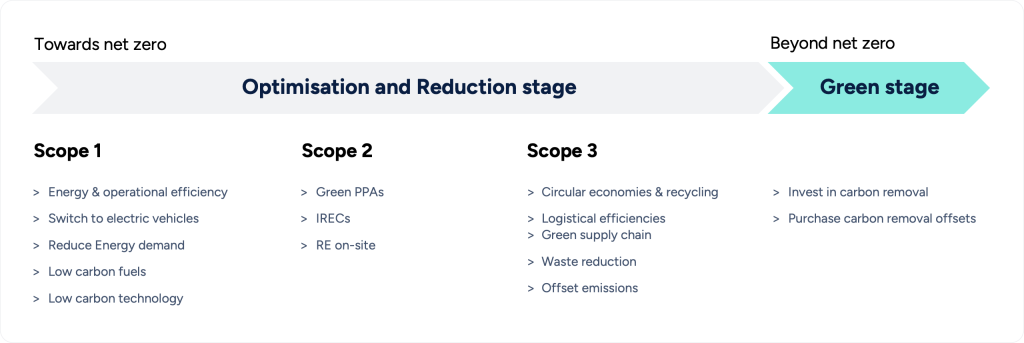The United Nation’s Emissions Gap Report acknowledges the role of voluntary climate action by businesses to bridge the gap between countries’ current policy commitments and what’s required to meet the goals set under the Paris Agreement. By adopting decarbonisation pathways – strategies to reduce or remove GHG emissions – companies can play a vital role in mitigating the impact of global warming. However, this is not just a moral imperative; it is also an economic one. With growing awareness of climate risks, corporations need to strategically decarbonise their operations to ensure they are sustainable and resilient to climate change. Leading companies are already pushing sustainability – 66% of the annual revenue of the world’s largest 2000 companies, amounting to 27 trillion USD, is now covered by a net-zero target. This article introduces the types of emissions under carbon accounting standards. We explain how a company can get started on their decarbonisation journey and set targets.
Understanding decarbonisation
Decarbonisation is the process of reducing or eliminating carbon dioxide emissions. It is a fundamental strategy in tackling climate change, particularly relevant to businesses due to their substantial contribution to global greenhouse gas (GHG) emissions. For instance industries consume over half of the total electricity produced in India which in turn contributes to 40% of India’s overall domestic GHG emissions.
The journey towards decarbonisation is not a one-size-fits-all. It involves assessing the nature and extent of emissions a business produces and then adopting the appropriate strategies to reduce these emissions.
Carbon Footprinting: how to calculate carbon emissions?
To effectively embark on a decarbonisation journey, businesses must first measure how much they emit. These emissions can be categorised into three scopes:
Scope 1: Direct Emissions – taking ownership of what you control
Scope 1 emissions directly stem from a company’s activities and operations. Think fuel burning in vehicles and boilers, industrial processes releasing GHGs, and even leaks from pipelines and storage facilities. Addressing Scope 1 emissions requires an inward focus on improving energy efficiency, adopting cleaner fuels like natural gas or renewables, and investing in carbon capture and storage technologies.
Scope 2: Indirect Emissions from Purchased Energy – choosing the right renewable energy source
While not directly generated by the company, these emissions arise from the purchase of electricity, heat, or cooling. The source matters here – fossil fuels like coal contribute significantly to Scope 2 emissions, while renewables like solar or wind power offer a cleaner alternative. Shifting towards renewable energy sources, participating in green energy programs, and improving overall energy efficiency are key strategies to tackle Scope 2 emissions.
Scope 3: Beyond the Fence – addressing the wider value chain
This category encompasses all other indirect emissions not covered under Scope 1 or 2. While challenging to measure and manage due to its expansive nature, ignoring Scope 3 paints an incomplete picture of a company’s true environmental impact. According to the GHG Protocol, it is the most complex, stretching across the entire value chain including emissions from the following:
- Upstream: Production, transportation, and processing of materials and goods purchased by the company.
- Downstream: Use of the company’s products or services by customers, like emissions from cars using the company’s fuel.
- Employee commuting: Emissions generated by employees travelling to work and for business purposes.
- Waste disposal: Emissions from landfills, incinerators, and other waste management processes.
- Processing of sold products: Intermediate products sold by downstream companies (e.g., manufacturers)
- Investments: Operation of investments including equity and debt investments and project finance.
- Franchises: Operation of franchises which are not included in Scope 1 and Scope 2 emissions.
- Fuel and Energy activities: Extraction, production, and transportation of fuels and energy purchased by the company inclusive of activities such as – emissions of purchased electricity and fuel, generation of electricity, steam, heating, and cooling that is purchased and sold to end users.
- Transportation and Distribution: Services the company bought during the reporting period covering inbound and outbound logistics (like delivering sold products), and transportation between the company’s facilities, all used vehicles and facilities not owned or controlled by the company.

Understanding the measurement methodologies
Carbon accounting has become essential for organisations to assess their current carbon footprint and fight against climate change. Some methodologies to measure footprint include:
- Spend-based: The spend-based carbon accounting method calculates the financial value of purchased goods and services and multiplies it with an emission factor. It offers a convenient and economical path for companies regardless of size, to gauge their indirect emissions.
- Activity-based: The activity-based method involves gathering and relying on granular data of business activities. This method helps companies monitor emissions from all parts of their supply chains and measure their Scope 3 emissions thoroughly. As a result, it can lead to better and more focused strategies for reducing emissions.
- Hybrid: Finally, the hybrid method combines integrating the best aspects of spend-based and activity-based methods, much recommended by the GHG Protocol, offering a balanced and comprehensive assessment of an organisation’s carbon footprint. This entails utilising all available activity-based data and then employing spend-based methods to estimate the rest.
Here’s why all companies must set climate targets
For companies, setting ambitious yet achievable climate targets is no longer a voluntary pursuit; it is a strategic imperative that demands careful planning and execution. This complex task requires navigating both internal and external drivers. Larger companies with wider reach and direct control can set bolder targets, further empowered by strong value chain management. Robust financial backing and R&D prowess fuel ambition by enabling investments in emissions reduction technologies.
Externally, stakeholder pressure from investors, customers, and NGOs drives action, posing reputational and market risks for inaction. Established industry standards and benchmarks offer valuable guidance, ensuring targets align with broader efforts. Regulatory landscape with carbon pricing schemes incentivise ambition, while market opportunities reward sustainability leadership, offering a competitive edge.
Ultimately, successful climate targets strike a delicate balance: science-based to contribute to global goals, ambitious enough to drive meaningful change, and achievable within resource and technological constraints. By comprehending these factors, companies can craft well-structured, multifaceted approaches to climate targets, navigating the path with confidence and contributing to a more sustainable future.
Corporations are increasingly dedicating strategic resources to define their decarbonisation strategies and pathways. A common strategy is to follow a glide path wherein:
- Operational and logistical efficiencies are improved to avoid emissions.
- Low carbon fuels and machinery are incorporated into operations to reduce emissions.
- Energy transition pathways are charted and executed to improve energy efficiency and ensure that energy demand is increasingly met using renewable energy.
- Emissions that cannot be avoided or reduced, called residual emissions can be offset using removal emissions or balanced by investing in the use of carbon removal technologies.
Depending on the intensity of the target and other sector specific factors such as emission intensity and availability of low-emission technological alternatives, actionable steps along the glidepath may be taken in a linear or non-linear manner.
Types of climate targets companies can set
The fight against climate change demands ambitious goals, pushing companies to move beyond “business as usual”. Three key targets offer a framework for action: carbon neutrality, net zero, and climate-positive.
As of March 4, 2024, 2980 companies have set science-based net-zero targets. Audi’s Ingolstadt plant will go net zero in 2024, aligning with the company’s goal of achieving net carbon neutrality at all its sites worldwide by 2025. Hilti Group, a major construction waste contributor, is embracing circular manufacturing for efficiency and aims to reach net-zero emissions by 2050 (CO2 neutral operations achieved). Meta has set a target to reach net-zero across its entire value chain by 2030 (building on its 2020 operational net zero). Indian restaurant aggregator Zomato aims for 100% electric vehicle deliveries and net zero emissions by 2033. Retail giant Marks and Spencer is demonstrating commitment with a 34% emission reduction goal by 2025/26 (2.1 million tonnes), ensuring they meet their SBTi approved target by 2030. These ambitious goals reflect companies’ environmental responsibility, responding to stakeholder demand and potential cost savings. As environmental concerns rise, expect even bolder sustainability goals in the future. Some of them are discussed here.
Carbon Neutrality – balancing the books
Imagine a company’s emissions as a scale. Carbon neutrality means balancing any CO2 released (e.g., through energy use) with an equivalent amount removed from the atmosphere (e.g., through carbon offsets). It is akin to achieving zero impact, minimising further contribution to climate change.
Net Zero – reaching equilibrium
Net zero takes the ambition further, aiming to eliminate all greenhouse gas (GHG) emissions, not just CO2. This broader focus acknowledges the complex impact of various gases on the climate. The Science Based Targets initiative (SBTi) provides the Net-Zero Standard, a valuable guide for businesses to set science-aligned net-zero targets and ensure their efforts contribute to global climate goals.
Climate Positive – moving beyond zero emissions
Climate positive goes above and beyond, actively removing more carbon than emitted. This involves not only reducing emissions but also actively investing in solutions like carbon capture and sequestration. Think of it as not just balancing the scale but tipping it in favour of a positive environmental impact.
Decarbonisation presents a strategic opportunity for businesses. Analysing the footprint across operations, energy, and supply chains helps identify identifies key improvement areas. Setting ambitious, achievable goals like carbon neutrality or net-zero emissions will help create a clear action plan. This path unlocks opportunities: improved efficiency, renewable energy adoption, innovative technologies, and collaborative partnerships.
Corporations are major contributors to global emissions and hold immense power to drive positive change. If corporations can cut emissions by 3.7 billion metric tons of CO2 equivalent annually by 2030, with increased participation and supportive policies, emission reductions could reach 10 billion metric tons by 2030, surpassing the Paris Agreement targets. Decarbonisation demands commitment, but the rewards – for corporations, the planet, and future generations – are immeasurable.



